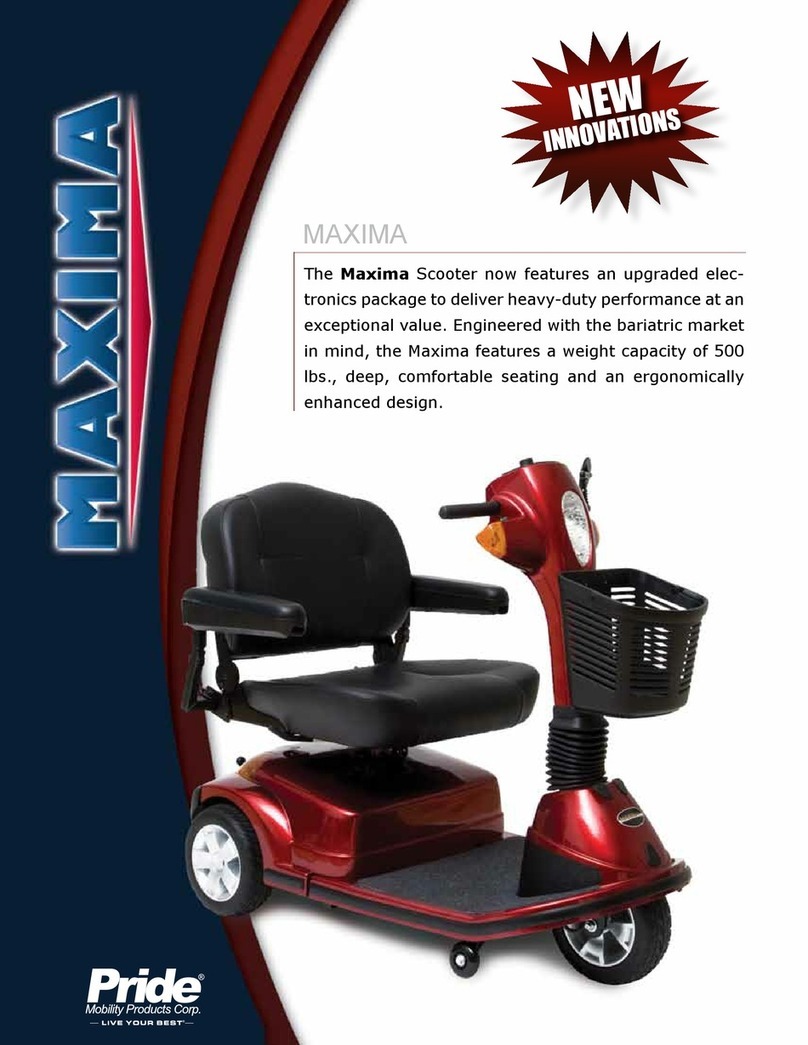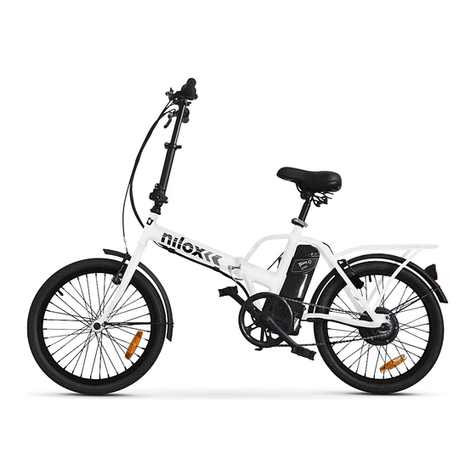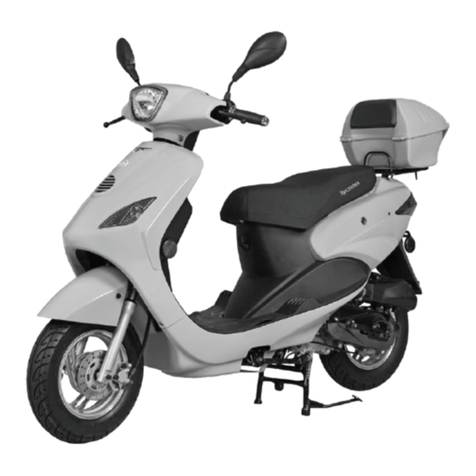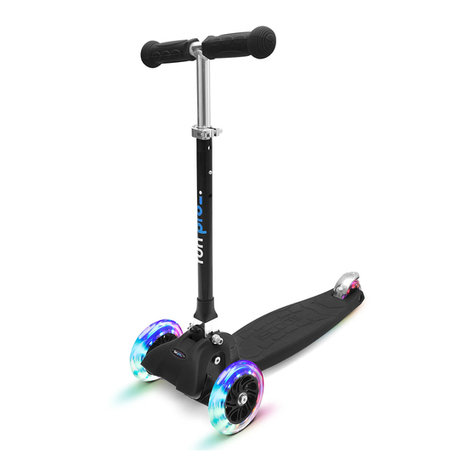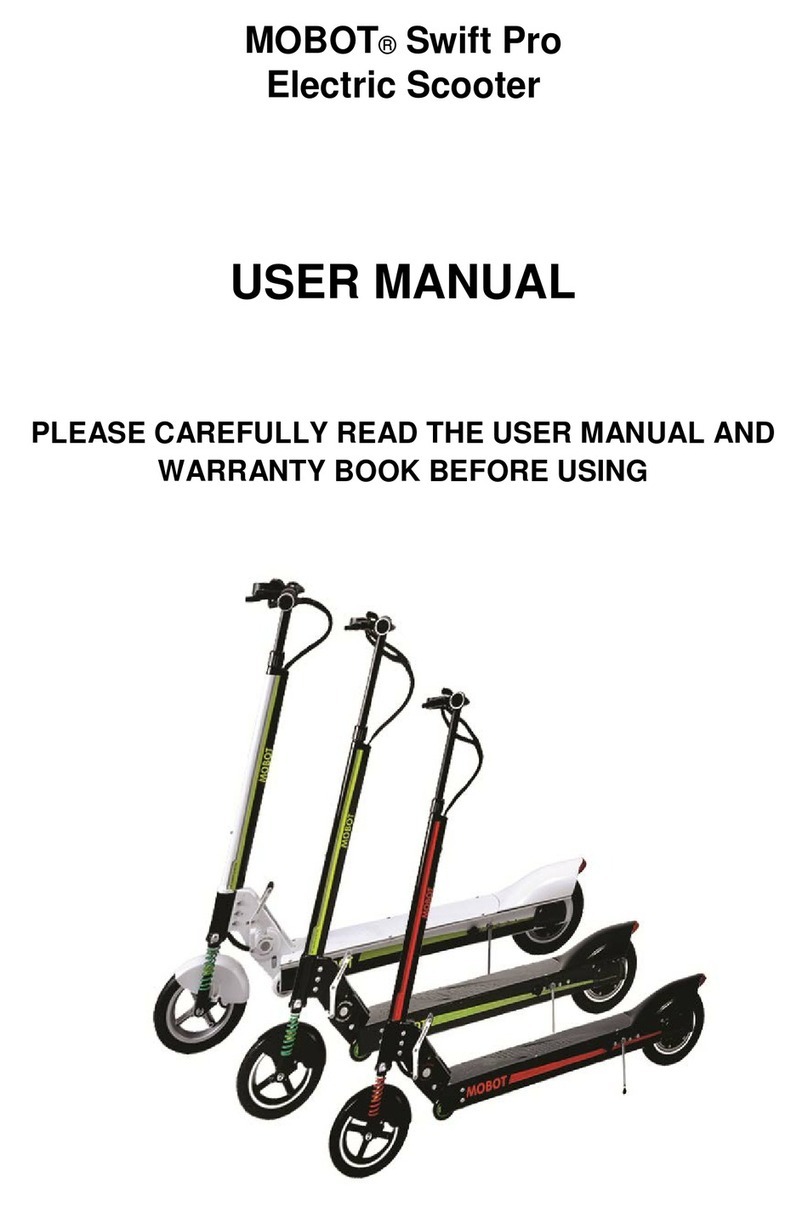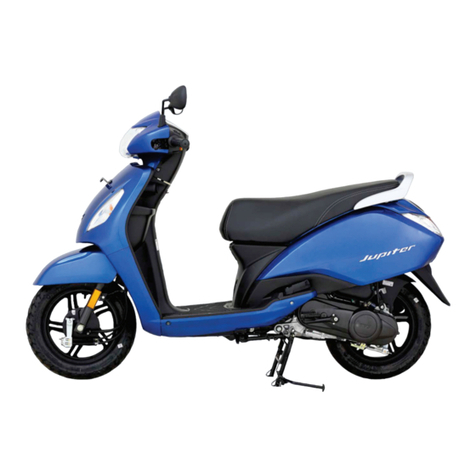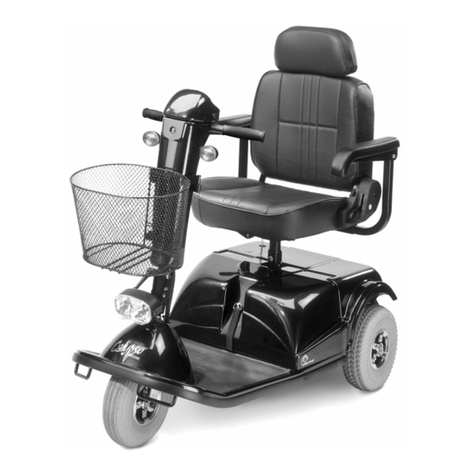Gehring Group Deluxe Fold Down User manual

User’s Manual
1. Safety instructions and notes
1.1 Safety instructions
1.2 Notes
2. Basic structure and name
3. Assembly method and requirements
3.1 Installation of headlight and front fender
3.2 Installation of front wheel
3.3Installation of front brake
3.4Installation of steering handle
3.5 Adjustment of Pedal, Tire, Power Assisting
4. Operation and adjustment
4.1Introduction of power assistant system
3.6 Charging
4.3Adjustment of quick release parts
4.4Reflection and lightening system
4.5 Safety height mark
4.6 Braking system
4.7 Speed control system
4.8 Damping system
4.9Rear rack
5. Use and maintenance
5.1 Routine inspection before use
5.2 Daily use, inspection and maintenance
6. Riding guidance troubleshooting

Electric-power- assistant bicycle, equipped with pedals and an auxiliary electric motor, which cannot be propelled
exclusively by means of this auxiliary electric motor, except in the start-up assistance mode, and the start-up assistance speed
is less than 6 km/h
Compared with bicycle, Electric bicycle only add motor, controller, charger, battery. When riding, electric power will
make riding easier and save labor.
Items in carton:
When you open the carton, please check if the following items are inside. If not, please contact with your agent.
Electric bicycle 1 pc
Charger 1 pc
Pedal 1 pair
Safety instructions and notes
1.1Safety instructions
People younger than 14 and older than 55 are forbidden to ride the electric bicycle.
Before carefully reading the Manual and understanding the performance of the electric bike, do not use the electric
bike, and do not lend it to the persons who cannot handle the electric bike.
Preparations before riding: wear your helmet, gloves and other protective gears before riding to protect yourself from
damage in case of an accident.
Cycling conditions: ambient temperature of -10℃-35℃,no wind and flat roads;
Max load: the max load of the electric bike is 75kg coupled with the max load (25kg) of the rear rack; Our
company shall not undertake any responsibility if an accident happens when the load is more than 100kg.
In case of frequent brake, startup, uphill, headwind running, muddy roads, overload and others, a large quantity of
electric power of the storage battery will be consumed, thus affecting the continued mileage, so we recommend that you
avoid the above factors when riding.
If the storage battery is disabled for a long time, make sure to charge it enough, and it need be additionally charged
once if its storage is more than a month.
Make sure to pay attention: the electric bike cannot wade for a long time because if water enters into the controller and
motor wheel, it may cause short circuit to damage the electrical parts..
Prohibit unauthorized demolition or alteration, and our company shall not be responsible for any losses caused.
The waste battery cannot be discarded randomly, so as to avoid environmental pollution.

Please usually check the brakes, tires, handlebar and rim for safety riding.
Please regularly check the rims of bike, especially for the rim of the V brake, that avoid the regularly using brakes
causing the rim edge thinning and affect the strength of the rim, resulting the tries blowout and result the user’s injury.
Please termly check the frame, fork and suspension connection, it may get injury if riders misuse.
1.2Notes
The electric bike is designed based on the original bike in combination with the market demand and is a means of
transport with special functions and uses. At the time of purchase, please select and buy a model suitable for your need, and
the drivers must have known driving technique before driving on the roads. In order for your correct use and security, please
pay attention to the following matters:
1. During your riding, please check whether motor and rear fork are well fastened and tighten them timely.
2. When turning on the power supply or coming across a slope during your riding, use the pedals to assist as far as
possible to reduce the surge current and extend the battery life and continued range.
3. In rainy days, when the water depth is higher than the wheel centre, and the water is likely to soak into the motor,
thus result in motor failure.
4. Users must use the dedicated charger. When charging the battery, please put the battery and the charger in a stable
and flat place.
5. Please take the charging process in a good ventilation environment, and it is prohibited cover the battery box or
charger with any things that may impede the heat dissipation.
6. Please keep appropriate tire pressure so as to avoid increasing the friction between the tire and the ground, which
may easily wear the tires and deforms the rim.
7. Users should abide by traffic rules, and the riding speed should be below 25km/h and the goods carried on the rear
rack should not exceed 25kg.
8. Do not use the front brake during high-speed running or downhill riding, in order to avoid the centre of gravity
from moving ahead and lead to accidents.
9. For safety-critical components failure, please purchase brand components, or contact the dealer for
replacement
10. The EPAC bicycle is not suit for install the child-seat. If you need to use the child-seat please note precaution
the children’s finger was trapped by the suspension saddle.
11. Please note the gap on the sample in normal use and maintain process, to prevent entrapment presented.
12. When cleaning, prohibit cleaning the frame directly with the water or any other liquid, it may lead to the
electric parts short circuit, damaged or fire accident. It is recommended cut off the power switch or remove
the battery, and then use wet cloth to wipe the vehicle surface when cleaning the bike. Prohibit using the gas,
water and other corrosive liquid to clean the body.

1. Basic structure and name
1. leather handle 2. LCD display 3. Shimano Shifter 4. Brake lever 5.stem 6. Stem folding clamp 7. LED light 8.
PET mudguard 9. suspension front fork 10. Wheel 11. Disc brake 12. Wheel Reflector 13.
Saddle 14. Seat post clamp 15. Battery 16. Frame folding clamp 17. Motor 18. Pedal 19. Kickstand

Correct Operation Stages !Warning:
For your safety concern, please practice in open tracts for the first time ride. After mastering the tricks, you may ride on
regular roads and follow the traffic rules consciously. Do not lend it to people who do not know how to ride the electric
bicycle, do not disassemble and refit the electric bicycle, please pay attention that brake in advance to allow longer braking
distance in rainy or snowy weather.
Operation Stages:
1. Start: insert the bicycle key into the power socket, turn to “On” position in the
clockwise direction, when the battery level indicator in bike meter is on, it Power Lock indicates the
power is on.
(Battery of Hanger Type: Click the switch of the battery pack on the “-” direction.)
2. Riding
A: Pedal Power Riding
Click the red button under the speed control switch to positioning state, press the pedal with foot in clockwise direction, then
the electric bicycle will drive forward normally. Stop pressing with pedal, the electric bicycle stop working, but it will still
drive forward a short distance because of inertance.
B: EV Riding
Click the red button under the speed control switch to reset state, turn the speed control switch with hands in anti-clockwise
direction, then the electric bicycle will drive forward normally, next move off the right hand, resume the speed control switch,
the electric bicycle stop working, but will still drive forward a short distance because of inertance.
Note: A: For your safety concern, please hold the grip tightly with both hands while riding, at least hold the brake with
two fingers, once there is situation against riding, please pull the brake timely.
B: This bicycle has the function of brake power cut, when riding, either brake, be left or right brake all will cut
off the motor power and ensure safety of riding. Please make sure all functions work well before riding. C: Please do
not turn the electronic speed control switch instantly as to make sure driving safety, and also protect the motor and
battery from damage.
2. Assembly method and requirements
3.1Installation of front fender
3.1.1Installation of front fender
1. Take out the front fender, and fix the fender hanger on the front fork with hexangular M6×30 bolts;
2. Put the front fender stick on the front fork, and fasten the nut.(as shown in the below pictures)

3.2Installation of front wheel
3.2.1Installation of common front wheel
1. Take out the front wheel, and loose the nut on the front hub;
2. Remove the black plastic rack below the front fork, and place the front wheel hub into the front fork contact pin;
3. Turn the nut to the front wheel hub, and tighten the nut with 15mm open-end wrench by 25-30N.m torque and put
the cover on the nut.
When fastening the nut for front wheel hub, press down the front fork appropriately so that the front wheel hub can
work closely with the front fork.
3.2.2 Installation of V brake
1.Take off the protect cover of V brake, and put V brake in the cage.
2.Squeeze V brake, and make the V brake cable in the V braket, then use M5 hexagonal wrench to fasten the bolt.
3.Hold the V brake repeatedly and see whether the brake shoes are symmetrically
Positioned on both sides of the rim. If not, please readjust
3.3Installation of front brake
3.3.1Mounting the rotor to the hub
1.Remove the wheel from the bike. Attach the rotor to the hub with the supplied Torx bolts and tighten with a T25 Torx
wrench. Final tightening torque:6.2 N.m.
2.Make the side with Tektro logo out (rotor must rotate same direction as wheel set) Tight rotor screw then install the
wheel on the front fork or frame.

Note: The rotor must be installed with the “rotation” arrows pointing in the same direction as the forward rotation of the
wheel.
3.3.2Mounting the adapter and caliper
1. Mount the relevant adapter to the caliper body. Insert 5mm bolts through the two adapter slots on the body and screw
into the holes on the adapter. Do not tighten yet.
2.Mount the caliper body and adapter to the frame/fork by placing the slot in the caliper body over the rotor. The
mounting holes on the adapter should be behind the frame/fork mounting holes (the hub side). Screw and tighten two 5mm
Allen bolts into the upper and lower holes in the frame/fork mount. Final tightening torque 6-8N.m.
3.Check that eh rotor is centered between the disc brake pads, and tighten the two bolts holding the caliper to the
adapter. To re-adjust the caliper positioning, loosen these two bolts and slide the caliper over until it is centered on the rotor,
then re-tighten the bolts. Final tightening torque 6-8N.m.
3.3.3 Installation of brake cable
1. Insert the cable through the cable adapter barrel on the caliper.
2. Making sure that the cable housing is firmly sealed within the cable adjuster barrel, insert the end of the cable
through the anchor bolt on the caliper. Take up slack in the cable, then tighten the cable anchor bolt. Final
tightening torque 6-8N.m.
3. Adjust the screw of the brake lever to fasten or loosen the brake cable.
Note: Be sure no more 20mm excess cable beyond anchor bolt.
3.4Installation of folding bike handle
1.Take out the handle , and remove the protective paper cover of the stem.
2.Insert the stem inside the Front fork stand pipe, and adjust the direction and depth,
3.Tighten the bolt inside the stem with 18N.m torque.
4.Lock the stem and folding parts.

3.5 Adjustment of Pedal, Tire, Power Assisting Hall Sensor
3.5.1. Pedal Installation and Adjustment:
Take out pedals from box, put one of pedals (of which the axial end has “L”) on the left side of the cyclist, and put another
(of which the axial end has “R”) on the right side of the cyclist. When installation, put the wrench stuck on the flat end of
pedal axial head, the right pedal twist into the crank in clockwise direction.
3.5.2. The Check and Adjustment of Tire Pressure Keep proper air pressure, the space between tire and ground contact is
about 10 centimeters long when riding on the electric bicycle.
4.Operation and adjustment
4.1Introduction of PAS system
The PAS system is also known as 1:1 PAS system. And the so-called 1:1 automatic power assisting is that when you do
not rotate the throttle but ride only by means of feet, the sensor will automatically sense your riding speed and control the
motor to assist you automatically in a driving force with the same speed, so as to make your ride easier and make a longer
range.
Operation of Your Display
There are 3 power-aid levels, which are “LOW” “MED” and“HIGH” The bike travels around 18km/h at level
“LOW”,22km/h at level ”MED”, and 25km/h at level “HIGH”.

Press the and “MODE” button to switch between different assist levels.
To the right of the “ ”button is the battery monitor, all of the 4 leds are active, which indicates that the battery is
full. Please recharge the battery whenever the number of active led is less than 2.
Press the “ ” button to turn the front light on and press “” again to turn the front light off.
4.2Charging
As it will last a certain period of time for the ex-factory, transport and storage of a new electric bike, it is likely to
result in shortage of the battery power, the battery should be charged before it is used.
Please use the dedicated charger, otherwise it might damage the battery, and may even lead to fire disaster or other
danger, then no warranty shall be provided by our company.
4.2.1Installation and charging of battery
Battery Mounting and Dismounting
1. Assemble the Battery
Mid-Mounted battery
Park the electric bicycle, make sure the key

cylinder of battery pack are on, make the opening groove behind the
battery pack align with the battery case slider, put the battery pack
down into along the battery case slider until the discharge hole at the
bottom of battery pack and the discharge plug of battery pack in
complete contact, finally press slightly with key into the inside key,
at the same time turn the key in a clockwise direction until the key
cylinder go through the hole on the battery case slider, then loosen
the key.
B: Mid-Mounted Battery
Park the electric bicycle, press slightly with the key
into the inside key, at the same time turn the key in
anti-clockwise direction until the key cylinder in
battery pack is completely independent from the hole
on battery case slider, then hold the handle on top of
the battery to pull out Battery Pack along the slider.

4.2.2Charging steps and method
Charge Methods and Steps
1. When the battery needs charging, please check the nominal voltage and charge plug of battery, choose the original
recharger that complies with the nominal voltage and charge plug of battery; It is forbidden to use the non-original
recharger to charge the battery to avoid serious safety accidents.
2. Insert the charging plug of recharger into the battery charge hole; pay attention to the plug direction, please do not insert
or dismantle by force.

3. Then insert the power plug of recharger into a household AC relocatable pad. Please do not insert the plug into the AC in
the stagnant water or when there is water on hands as to avoid causing electric shock hazards.
4. Please check the recharger indicator. When the indicator on the recharger is red, it indicates the battery is charging, when
the indicator is green, it indicates charging completed.
5. After charging completes, please pull out the recharger power plug from the household AC relocatable pad.
Attention:
1. Make sure the recharger is the original recharger.
2. All charge plugs must insert tightly, no loose and with good contact.
3. The recharge time of whole battery pack is 6-8 hours, please operate in strict accordance with above instructions and
Keep recharge in the place where the children could touch.
4. Please do not charge in a place where rain would be on it.
1. Carefully check whether the rated input voltage of the charger is consistent with the supply voltage.
2. The battery can be directly put on the bike for charging and can also be taken down from the bike to be charged
indoors and at other appropriate places.
3. Connect the output plug of the charger with the charging port of the battery and then connect the input plug of the
charger with AC power supply.
4. The power indicator of the battery and the charger are on, which means that the charging is connected.
5. After charging, first pull out the input plug of the charger, then the output plug. It needs 6-8hrs for the charging,

when the indicator turns green instead of being red, then the battery is fully charged.
A new bike might well be recharged for 8-9 hrs after a deep discharging for the first time. It is to activate the active
substances inside the battery. Later, it can be re-charged even if its power is not used up.
Common sense of charging and use:
The battery should be charged in a spacious environment, staying away from high temperature, high humidity and
close fire, because the battery and the charger are electronic products, high temperature and humidity will corrode electronic
components, resulting in some harmful gases or smog, and may even cause explosion.
The charging time should not be too long, or it may shorten life expectancy of the battery.
After the battery is fully charged, the power supply should be pulled out as soon as possible, and at the same time cut
off the connection between the battery and the charger.
When the battery is not used for a long time, the battery power should be discharged till 50% power left, and it should be
charged per month or so.
4.3Quick release folding system
4.3.1 Quick release system of the seat
1. Move the quick release handle to the OPEN position
2. Clockwise rotate the nut till it contacts with the saddle clamp, and then turn counterclockwise for a circle or
semi-circle, then push the quick release handle to the CLOSE position.
4. Push the side position of the saddle head and the upper part by force; if the saddle is not stable, please first check
whether the saddle clamp is locked. If so, please repeat the operations above.

4.3.3Folding method of folding bike
1.Push the black clockwise.
2.Push downward the lever and rotate backward the stem.

3.Rotate black lever first then the silver one.
4.Rotate the front end of the frame to the left.
4.4Reflection and lighting system
The reflection system includes a reflector on the rim, front and rear passive lamp, backpack, helmet and reflective
patch on riding clothes.
The lighting system is mainly the battery or the self-power-generated front and rear lamp. These items help to mark
your own position when riding at night, convenient for pedestrians and other vehicles on the roads to avoid. (Tips:
please abide by local laws and standards for the reflection and lighting system)
4.5Safety height mark
4.5.1Safety height mark of the stem
The stem can be properly adjusted depending on personal riding habit, but the safety mark cannot be exposed; It may
cause serious injury in case of improper operation.
Adjustment method:
1. Loosen the screw in the middle of the stem
2. Move the stem to a certain height, and do not make the safety mark exposed.
3. Fasten the screw.
4.5.2Saddle position
When you sit on the saddle to tread on the pedal flatly by heel, when the pedal is at the lowest position, legs slightly
stretch, and at this time it is the most suitable height; if the rider can tread on the pedal only by toes or legs cannot stretch
slightly, fatigue and sports injury will be caused, so there is a careful need for adjustment of the height of the saddle post.
The saddle post has a max mark line, that is safety height mark which cannot be exposed. In case of improper use,
serious injury may be caused.

Saddle angle: In order to avoid leaning forward when riding, it is appropriate for the front end of the saddle to lean
upward, the front and rear position can be appropriately adjusted based on individual height.
Minimum height of the saddle: move the quick release handle to the OPEN position, then put the saddle post to the
lowest place, and when the saddle post cannot enter into the saddle tube of the frame, it is the minimum height of the seat.
Maximum height of the saddle: move the quick release handle to the OPEN position, then lift the saddle post to the top
but the safety line is not exposed, it is the maximum height of the saddle.
Measuring method: place the bike perpendicular to the ground, and the distance from the highest part of the curved
surface of the saddle vertical to the ground is the height of the saddle.
4.6Braking system
The braking system is an accessory necessary for each bike and is the key to traffic safety; before driving, you must
understand your braking system, and do a good job in the inspection and adjustment work.
The general idea is that upon hard braking, the bike will surely stop in a short distance, but that is wrong. Upon hard
braking, when the wheels are suddenly jammed by the brake rubber, the bike will glide horizontally, and it not only is
dangerous but the braking distance will be lengthened. Therefore, the concept should be established is that the braking
system is only used to adjust the speed of the bike.
The braking system typically includes a brake handle, brake (disc brake, V brake, and many other types of brakes) and
brake cable.
The structure of the brake handle is as shown, the left brake handle controls the front brake and the right brake
handle controls the rear brake.

The effective stroke of the brake cable is about a half of the distance between the brake lever and the grip;
Common sense of the use of braking system
When the distance between the brake shoe and the rim is too large, it is adjusted by the brake lever or the clamp.
When the brake cable or brake shoes are worn seriously, replace it timely in order to maintain traffic safety.
When riding in rainy days, the function of any gate device will be weakened, so please keep a longer safe braking
distance and reduce the speed.
The surface on the brake disc, brake shoes cannot be oiled, so as to avoid serious damage.
If the brake cable is ripped, it may cause the brake cable to be broken and this is very dangerous, please replace timely.
4.7Speed control system
The speed control system is used to cater for various terrain and clockwise and counterclockwise wind conditions, and
to mix with physical strength appropriately.
The entire speed control system includes a derailleur, front and back fender, chain plate, and flywheel and shift cables.
The number of speed change series is the number of fluted disc×the number of flywheel pieces
For example: three pieces of chain plate ×6 flywheel pieces =18 speed change series, and so on.
4.7.1Derailleur

Type of derailleur: dial type (as shown)
The derailleur is separately positioned on both sides of the handle, and the left controls the front one, the right controls
the rear one.
4.7.2Adjustment of the derailleur
The derailleur is classified into the front derailleur and back derailleur
When the shift cables are loose or too tight, if the speed controller doesn’t work properly or the chain falls off, the H, L bolt
is adjusted.
H bolt: when the chain speed changes to the biggest fluted disc, the chain will fall off, and the H bolt will be locked.
But if it is too tight, the chain can’t climb to the biggest fluted disc.
L bolt: when the chain is toward the inside fluted disc and the chain falls off, the L bolt is locked. But if it is too tight,
the speed change can’t be downward. Therefore it is appropriate to adjust the H, L bolt to a suitable position.

4.7.3Chain
When the chain and elongate it to a certain extent, it will in the chain will climb to the chain wheel and jump, and at
this time the chain has not meshed with the chain wheel correctly, thus affecting the cycling performance; in case of such a
situation, the chain should be timely adjusted.
To determine the length of the chain: adjust the front derailleur to the lowest shift (the smallest tooth of the chain ring)
and also adjust the back fender to the lowest shift ( the smallest tooth of the flywheel) to check whether the chain sag is
more than 15mm (as shown). If it is more than 15mm, the chain is too long, please go to your supplier to shorten the chain
in order to maintain the best cycling performance of your bike.
Common sense of the use of speed control system
Do not tread reversely in the course of speed change so as not to lead to failure and the chain falls off.
As far as possible, do not change the gear-speed ratio substantially and should change the speed in accordance with the
order.
If the electric bike is idle for a long time, the chain will be changed to the minimum keyboard tooth and the smallest
flywheel, so as to avoid fatigue of the mechanical flexibility.
The chain, fluted disc, flywheel, derailleur should be always washed, wiped, and lubricated (oiled appropriately).
4.8Damping system
Damping can keep the tire buffer contact with the ground when your bike is running on the uneven road so that the
driver feels more comfortable while driving on the uneven road.
Damping hardness can be adjusted by adjusting the damping coefficient according to road conditions and personal
preference.
Adjustment method of damping ( as shown): rotate toward the “+” direction to increase the damping coefficient, thus
increasing the damping hardness; rotate toward the “-“ direction to reduce the damping coefficient thus decreasing the
damping hardness.

4.9 luggage carrier
1. The largest load of the luggage carrier is 25Kg;
2.Do not adjust the luggage carrier arbitrarily, please consult the supplier to make an adjustment if necessary; Don’t to
modify the luggage carrier.
3.Do not transport heavy objects; if a heavy object is put on the rear rack, the bike’s steering performance will be
affected and the braking performance will be reduced, as will result in danger
4.The assembly of the luggage carrier is (as shown):
5.When you need to use the rear rack, Please check whether the screws are tight.
6.Don’t pull a trailer ont the luggage carrier.The bicycle may behave differently (particularly with regard to steering and
braking) when the luggage carrier is loaded;
Ensure that any luggage or child-seat fitted to the luggage carrier is securely fitted in accordance with the
manufacturer’s instructions and that there are no loose straps that can get caught in any of the wheels;
7. When luggage is attached to the luggage carrier, don’t obscured the reflectors and lamps;distribute luggage evenly
between the two sides of the luggage carrier.
5.Use and maintenance
5.1Routine inspection of electric bike before use
1. Install the battery box in the slot of the battery box, open the power supply switch and check whether the functions
of all the electrical appliances are normal.
2. Safety inspection(see the notes to safe use in the Manual)
3. Check whether the governor switch handle rotates and resets flexibly.
4. Check whether the braking power-off function and braking effect are in good condition (braking distance on dry
pavement : 4m, on wet pavement :15m)
Table of contents

